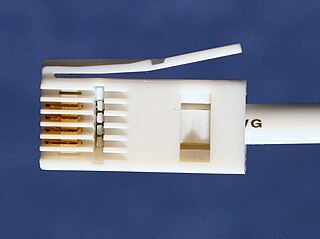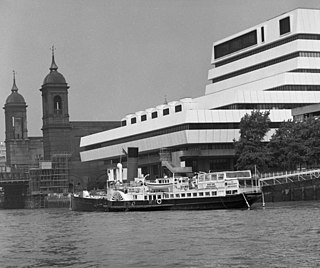The Digital Private Network Signalling System (DPNSS) is a network protocol used on digital trunk lines for connecting to PABX. It supports a defined set of inter-networking facilities.
The General Electric Company, or GEC, was a major British industrial conglomerate involved in consumer and defence electronics, communications, and engineering. The company was founded in 1886, was Britain's largest private employer with over 250,000 employees in the 1980s, and at its peak in the 1990s, made profits of over £1 billion a year.
The Plessey Company plc was a British electronics, defence and telecommunications company. It originated in 1917, growing and diversifying into electronics. It expanded after World War II by acquisition of companies and formed overseas companies.
The International Mobile Equipment Identity (IMEI) is a number, usually unique, to identify 3GPP and iDEN mobile phones, as well as some satellite phones. It is usually found printed inside the battery compartment of the phone but can also be displayed on-screen on most phones by entering *#06# MMI Supplementary Service code on the dialpad, or alongside other system information in the settings menu on smartphone operating systems.
Network switching subsystem (NSS) is the component of a GSM system that carries out call out and mobility management functions for mobile phones roaming on the network of base stations. It is owned and deployed by mobile phone operators and allows mobile devices to communicate with each other and telephones in the wider public switched telephone network (PSTN). The architecture contains specific features and functions which are needed because the phones are not fixed in one location.
The Type Allocation Code (TAC) is the initial eight-digit portion of the 15-digit IMEI and 16-digit IMEISV codes used to uniquely identify wireless devices.

On commercial products, the letters CE mean that the manufacturer or importer affirms the good's conformity with European health, safety, and environmental protection standards. It is not a quality indicator or a certification mark. The CE marking is required for goods sold in the European Economic Area (EEA), but is also found on products sold elsewhere that have been manufactured to EEA standards.

Marconi Communications, the former telecommunications arm of Britain's General Electric Company plc (GEC), was founded in August 1998 through the amalgamation of GEC Plessey Telecommunications (GPT) with other GEC subsidiaries: Marconi SpA, GEC Hong Kong, and ATC South Africa.
GEC Plessey Telecommunications (GPT) was a British manufacturer of telecommunications equipment, notably the System X telephone exchange. The company was founded in 1988 as a joint venture between GEC and the British electronics, defence and telecommunications company Plessey. The next year, after a joint holding company of GEC and the German conglomerate Siemens AG acquired Plessey, GPT was converted into a 60/40 GEC/Siemens joint venture. The GPT name ceased to be used in the mid-1990s, and in 1998 the company was amalgamated into Siemens Communications.
System Y is the terminology used by BT, the main operator of the telephone network in the United Kingdom, to refer to the Ericsson AXE digital switching system.

Standard Telephones and Cables Ltd was a British manufacturer of telephone, telegraph, radio, telecommunications, and related equipment. During its history, STC invented and developed several groundbreaking new technologies including pulse-code modulation (PCM) and optical fibres.
The Reporting Body Identifier is the first two digits of a Global System for Mobile Communications (GSM) Type Allocation Code, and indicates the GSMA-approved organization that registered a given mobile device, and allocated the model a unique code.
A mobile equipment identifier (MEID) is a globally unique number identifying a physical piece of CDMA2000 mobile station equipment. The number format is defined by the 3GPP2 report S.R0048 but in practical terms, it can be seen as an IMEI but with hexadecimal digits.
Phone cloning is the copying of identity from one cellular device to another.
A Central Equipment Identity Register (CEIR) is a database of mobile equipment identifiers. Such an identifier is assigned to each SIM slot of the mobile device.
TXK was a range of Crossbar exchanges used by the British Post Office telephone network, subsequently BT, between 1964 and 1994. TXC was used as the designation at first, but this was later changed as TXC sounded too much like TXE the code used for later electronic exchanges. Prior to this the GPO had standardised on Strowger for automatic switching and had resisted the adoption of Crossbar, preferring to wait for its electronic switching research to bear fruit. The development of electronic systems however took longer than anticipated and the British equipment manufacturers, particularly Automatic Telephone & Electric (ATE), which later became part of the Plessey group feared that continuing to focus the bulk of their production on Strowger equipment would harm their export sales as Crossbar had already become popular throughout the world.

British telephone sockets were introduced in their current plug and socket form on 19 November 1981 by British Telecom to allow subscribers to connect their own telephones. The connectors are specified in British Standard BS 6312. Electrical characteristics of the telephone interface are specified by individual network operators, e.g. in British Telecom's SIN 351. Electrical characteristics required of British telephones used to be specified in BS 6305.
In 2009, a European Commission initiative resulted in the specification of a common external power supply for use with data-enabled mobile phones sold in the European Union. The external power supply is the AC electric power adapter that converts household AC electricity voltages to the much lower DC voltages needed to charge a mobile phone's internal battery. Although compliance is voluntary, a majority of the world's largest mobile phone manufacturers agreed to make their applicable mobile phones compatible with Europe's common external power supply specification.
Sir John Allen Clark was managing director of the British Plessey Company, an electronics and telecommunications group built up by his father, Allen George Clark. His career with Plessey was dominated by a battle with Arnold Weinstock of GEC for control of the company together with English Electric from the 1960s. This culminated in the late 1980s with the takeover and break-up of Plessey.

Mondial House was a main telecommunications hub in central London on the banks of the River Thames. It was known as an international switching centre (ISC). Built in 1978 the building was seen as controversially modern-looking. It was demolished in 2006.





